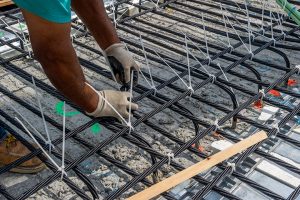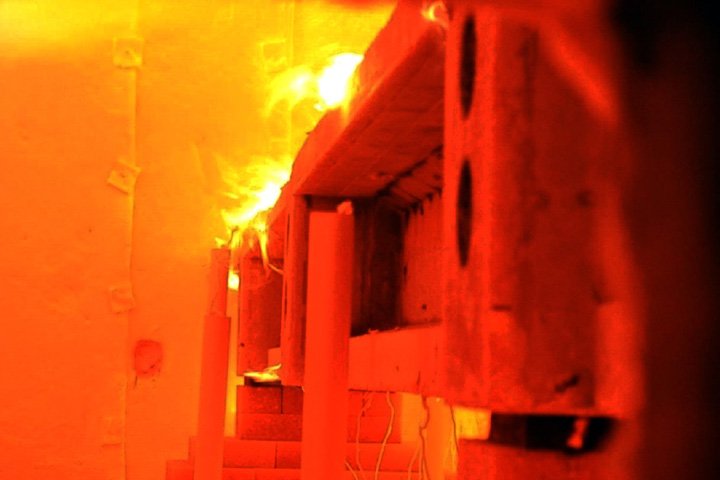LANSING, Mich. — The Michigan Department of Transportation (MDOT) and researchers at Lawrence Technological University have subjected a high-tech material to trial by fire and ice in a quest for better bridge components.
Steel has historically been the go-to material for reinforcing and pre-tensioning concrete for highway bridges. Steel adds much-needed strength, but it is prone to corrosion and deterioration under assault from extreme temperatures, water and deicing chemicals, and preventing corrosion and repairing damaged areas require maintenance time and resources.

MDOT and Lawrence Tech have pioneered an alternative to steel in critical bridge applications in an effort to create strong, longer-lasting structures — carbon fiber. Carbon fiber strands have a tensile strength comparable to steel, but they resist corrosion and require less maintenance over time.
The joint study has been named one of the top research projects of 2020 by the American Association of State Highway and Transportation Officials’ (AASHTO) Research Advisory Committee.
Under the direction of Dr. Nabil Grace, dean of the College of Engineering at Lawrence Tech, the school’s Center for Innovative Materials has been researching carbon fiber reinforced polymer (CFRP) since 1988, funded through multiple research awards from the National Science Foundation and MDOT.
“In 2001, Lawrence Tech, MDOT and the City of Southfield worked together on the deployment of the first three-span CFRP pre-stressed concrete bridge in the country,” Grace said. The Bridge Street Bridge was outfitted with a variety of sensors and will be monitored by MDOT until 2025.
“CFRP has performed well in the field but its long-term durability wasn’t fully understood,” said Matthew Chynoweth, MDOT’s chief bridge engineer and director of the department’s Bureau of Bridges and Structures.
However, carbon fiber components did not have a track record in transportation infrastructure, and engineers lacked the technical specs needed to optimize the CFRP design process and encourage more widespread use of the material. To correct this, MDOT and Lawrence Tech collaborated again beginning in 2013, this time to test the short- and long-term performance of CFRP strands and beams under a wide range of conditions.
During four years of extensive research, carbon fiber components were subjected to 300 freeze-thaw cycles, combined fire/loading events, severe weather and other trials by the researchers. As a result, bridge designers now have the information and specifications they need to predict how CFRP will perform under a variety of real-world conditions, as well as the design tools for future bridge projects.
“This research allowed us to test every question we had about CFRP and get good data so that we can continue to design bridges that are as safe and durable as normal steel bridges but without steel’s corrosive limitations,” Chynoweth said.
Researchers found that CFRP strands held up well to conditions that simulated Michigan’s harsh weather: Moisture, rain, freezing rain and extreme temperature swings did not significantly affect the material’s strength or mechanical properties over time. In addition, test results showed that some currently accepted parameters for CFRP are conservative and can be updated.
The research generated criteria, guidelines and recommendations to make MDOT’s design and construction of highway bridges using CFRP components more efficient. Additionally, researchers prepared design examples, valuable reference tools for bridge designers.
These efforts have already received recognition.
“Recently, AASHTO published its first design specification for CFRP pre-stressed concrete bridge elements, and this was mostly inspired by the work Dr. Grace has done for the past 30 years,” Chynoweth said.
Practical applications for carbon fiber components are also expanding. Backed by previously unavailable real-world data for CFRP, engineers are making use of the material. Since the first carbon fiber components were used in 2001, more than a dozen bridges have been built throughout the state using CFRP pre-stressing and post tensioning. Some recent examples include the southbound Interstate 75 span over the Sexton-Kilfoil Drain in Detroit, which incorporates 140-foot CFRP pre-stressed beams; and two bridges that are being built as part of MDOT’s Interstate 94 modernization project, also in Detroit.
What is the future outlook for carbon fiber in MDOT bridge design? One barrier to wider adoption is the cost of materials.
“Cost is always an issue. That is why we only do a few bridges per year,” Chynoweth said. “However, one of our main suppliers, Tokyo Rope, built a fabrication facility in Michigan, which has cut down on some costs and delivery times for CFRP.”
Thanks to a deeper understanding of carbon fiber materials, bridge designers are closer to realizing their goal of building longer-lived bridges. A bridge with a minimum 100-year service life is an MDOT, as well as a national, target. AASHTO’s new specification for bridge design focuses on promoting innovative materials to achieve these longer life spans.
“Since CFRP is non-corrosive, we are eliminating the potential of concrete deterioration from steel corrosion, which is the major cause of shorter service lives on bridges,” Chynoweth said.
For a summary of the report on using CFRP in bridge designs, click here; or click here for the full final report.
The Trucker News Staff produces engaging content for not only TheTrucker.com, but also The Trucker Newspaper, which has been serving the trucking industry for more than 30 years. With a focus on drivers, the Trucker News Staff aims to provide relevant, objective content pertaining to the trucking segment of the transportation industry. The Trucker News Staff is based in Little Rock, Arkansas.








